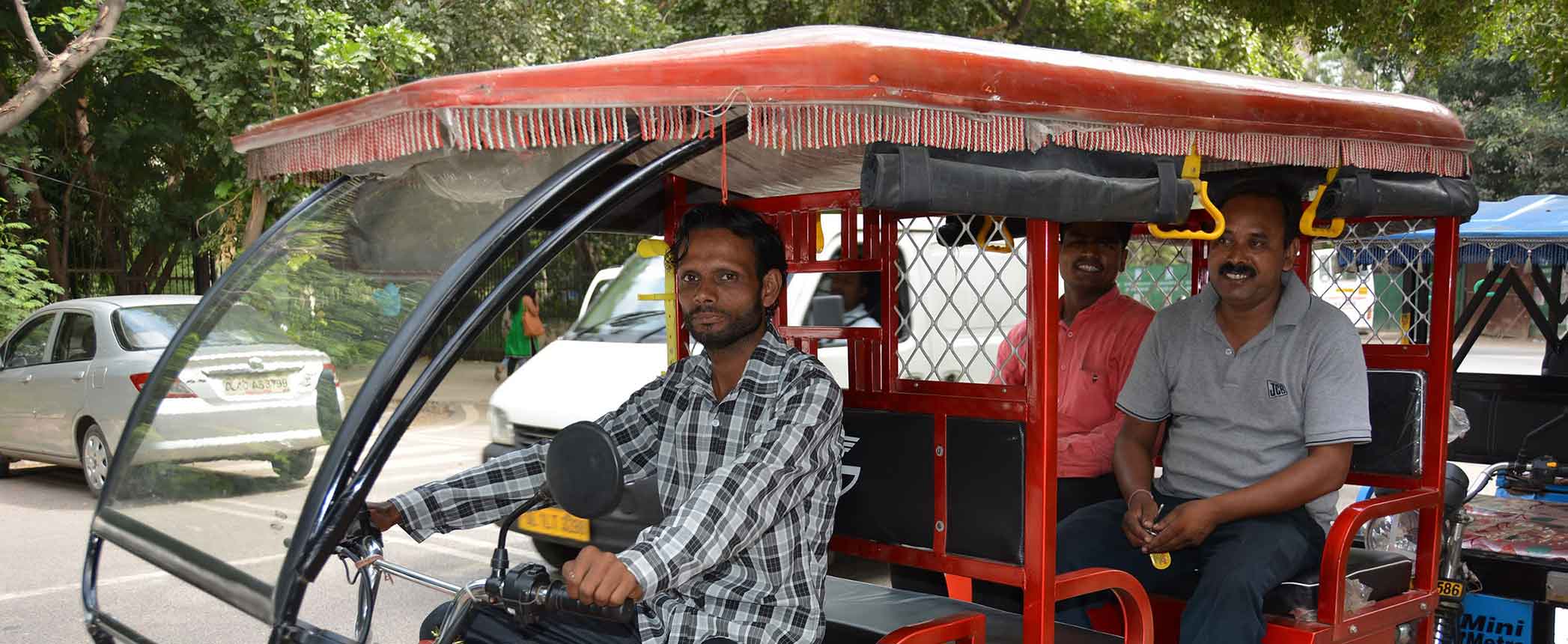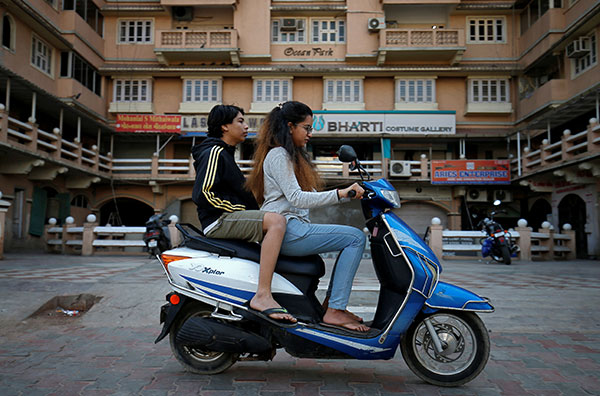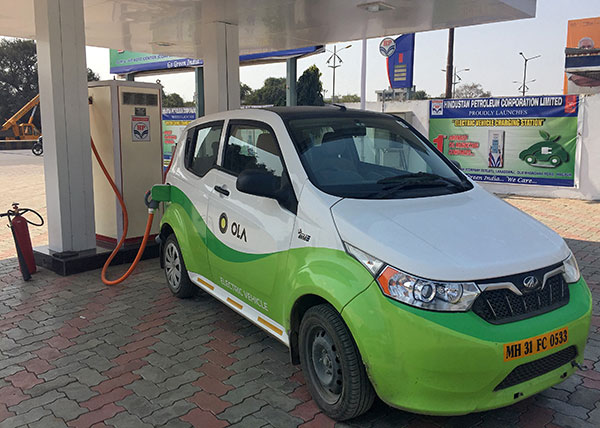
With the global focus on EV cars, two- and three-wheelers could be a bigger growth area in developing economies such as India, but there are still obstacles to surmount.
India is one of the fastest-growing automotive markets in the world and is not immune to the growing shift toward low- and zero-emissions vehicles. The country, with a population of more than 1.3 billion, is not only set to implement stricter automobile emissions standards from April 2020 to tackle worsening air pollution, but also recently increased its incentives to promote electric vehicles.
In February 2019, the government approved phase two of the Faster Adoption and Manufacturing of Electric Vehicles scheme, known as FAME, for the promotion of electric mobility. Phase one was launched in April 2015 and offered buyers U.S. $127 million worth of point-of-purchase incentives for EVs. This year, the government raised that sum to $1.4 billion to encourage faster adoption of electrified vehicles, growth of charging infrastructure, research and development and indigenous production.
Phase two of FAME, effective from April 2019, will be implemented over the next three years with an emphasis on the three- and four-wheeler public transport and commercial segments and private two-wheelers. The scheme’s target is to support the purchase of 1 million two-wheelers, 500,000 three-wheelers, 55,000 four-wheelers and 7,000 buses.
FAME phase two also proposes the establishment of about 2,700 charging stations in metropolitan areas and cities across the county, including in the Hill States, with an aim of at least one charging station in a grid of 3 square kilometers. Charging stations will also be set up on major highways connecting key city clusters.
Shantanu Jaiswal, head of India research at Bloomberg New Energy Finance, said the government has finally warmed to the fact that they missed out to China in a few sectors such as semiconductors and renewable energy equipment. Now they want to take advantage of EV manufacturing opportunities.
“They don’t want to lose Indian manufacturing ability to the Chinese because auto is a big industry for India,” he told Lubes’n’Greases on the sidelines of the ICIS Indian Base Oils & Lubricants Conference in April this year.
However, FAME phase two has turned out to be a disappointment for the Indian EV manufacturing industry due to stringent eligibility criteria for claiming electric two-wheeler incentives – incentives will only be offered for vehicles fitted with advanced battery types, such as lithium ion.

Under FAME phase one, an incentive was provided to all battery-powered vehicles, including those that run on lead-acid batteries. Until September 2018, about 90 percent of the beneficiaries of FAME phase one were lead-acid powered electric scooters, according to data collected by Mumbai-based Crisil Research, an S&P Global research company. But the incentive for lead-acid battery powered vehicles was discontinued in October, dealing to a blow to electric scooter sales.
FAME phase two continues to exclude lead-acid battery two-wheelers. In addition, the latest eligibility terms stipulate electric scooters must have a minimum range of 80 kilometers per charge and a minimum top speed of 40 km per hour, along with requirements for energy efficiency, minimum acceleration, a higher number of charging cycles and 50 percent manufacturing localization.
“Our assessment of the product portfolio of various EV manufacturers indicates that the electric two-wheeler segment would be impacted the most by FAME phase two rules,” Crisil found in a report. “We believe more than 95 percent of the electric two-wheeler models being produced now won’t be eligible for incentives under FAME phase two.”
Crisil also reported that previously the incentive for lithium-ion battery two-wheelers was up to $312, based on the potential fuel savings and irrespective of the battery’s size. However, FAME phase two has linked the incentive to the size of the battery, with the government providing $142 per kilowatt hour of battery.
“The proposed subsidy of $142/kwh is grossly inadequate and will be a waste rather than an incentive,” Manu Sharma, director of corporate affairs at the Society of Manufacturers of Electric Vehicles, wrote in a letter to the government in April.
The New Delhi-based SMEV, which represents India’s EV and component manufacturers, urged the government to reconsider the stringent eligibility criteria to support electric two-wheeler sales. The industry body has asked the government to not link localization and ex-showroom price (the cost of the vehicle plus state tax before the dealer’s markup) to subsidies, to keep 60 km as the range eligibility and to increase the subsidy to $284/kwh, in line with the bus battery subsidy.
“EV makers have been caught off guard by the stringent eligibility criteria leaving them no time to conform,” the Crisil report also commented, adding EV manufacturers in India may need to scramble to conform with stringent FAME phase two requirements unless the government helps out by diluting them.
Bloomberg NEF’s Jaiswal said negligible local battery manufacturing capacity, the slow response by automakers to introduce new electric cars to the market, a lack of clarity on long-term policy and inadequate public charging infrastructure are some of the factors stunting growth.
The four-wheeler EV industry in India is nascent compared with the traditional domestic automobile market, which saw sales of 26.8 million two-, three- and four-wheelers in 2018, up 12.7 percent from a year earlier. However, of India’s nearly 3 million EVs, 79 percent are three-wheelers and 20 percent two-wheelers, with four-wheelers accounting for less than 1 percent, SMEV data showed.
Even so, sales volumes have been fluctuating, largely due to the government incentives. In the year ending Mar. 31, India’s total EV sales declined 16 percent year-on-year to 759,600 units due mainly to weak three-wheeler sales, according to provisional data by SMEV, which fell nearly 26 percent to 630,000 units. However, sales of two-wheelers jumped 130 percent to 126,000 units, and those of electric cars surged 200 percent to 3,600 units in the financial year 2018-19.
An official with SMEV said electric two-wheeler sales in April 2019 dropped as vehicles sold in the country are currently unable to meet the FAME phase two criteria set by the government.
But the future is looking up for the sector. Jaiswal said battery prices, which account for half of the cost of an EV, tightening fuel economy laws and migration to India’s national Bharat Stage VI emissions regulations, state-level incentives to promote EV manufacturing and demand, volatility of global crude oil prices, rising pollution levels in major cities and increasing demand from fleet operators will drive local industry growth.

“The EV has to establish itself as a good alternative commercial model in comparison with the internal combustion engine, and a lot will depend on how the infrastructure comes up for charging stations,” said a top executive with a leading fuel and lubricant additives manufacturer, declining to be identified. He added charging infrastructure is scant in the country.
S. Krishnan, senior vice president of engine development division at Chennai-based commercial vehicle maker Ashok Leyland, echoed the sentiment. Availability, acceptability and affordability are key to growth of EVs in India, he said. “The government has to invest [for EV growth]. If there is no mass scale, then how can it be done?”
Bloomberg NEF, which provides primary research on clean energy and advanced transport, projects that 32 percent of the 10 million new cars sales in India will be electric in 2040, while 13 percent of around 115 million cars on Indian roads would be electrified by 2040.
The government, in a report titled India’s Electric Mobility Transformation, said EV sales could account for 30 percent of passenger cars, 70 percent of commercial vehicles, 40 percent of buses and 80 percent of two- and three-wheelers by 2030, if FAME phase two and other measures are successful.
Sharbel Luzuriaga, project manager at the United States-based consultancy Kline & Co., thinks otherwise. “The Indian government has very ambitious EV targets, but original equipment manufacturers and market dynamics reflect a less optimistic view,” he told Lubes’n’Greases, adding that India belongs to a group of countries with expected low EV penetration through 2040.
Sandur Ajith Kumar, a consultant in the research and development division of India’s third-largest two-wheeler manufacturer TVS Motor, said scooters will transition to electric motors faster than motorcycles because scooters are mainly used for short commutes, and recharging the batteries will be easy and economical. He predicted significant growth in electric scooters will occur by 2025, but added that they will not overtake ICE models yet.
Hero Electric, Mahindra Electric, Tata Motors, Lohia Auto Industries, Electrotherm (India), Avon Cycles, Okinawa Autotech, Ather Energy and Atul Auto are some of the major players in the Indian EV market. Several other players, including Maruti Suzuki India, Nissan Motor, Kia Motors and Hyundai Motor, are also planning to launch EVs in the future.
The greater penetration of EVs presents a challenge to lube suppliers globally, as it affects demand. Heavy-duty engine oil and passenger car motor oil account for 23 percent and 21 percent, respectively, of estimated global finished lubricant demand of about 36.4 million metric tons. Gear oil, transmission fluid, wheel bearing and chassis grease account for around 9 percent.
Luzuriaga said the PCMO market has not yet felt much of an impact from EVs, and the trend is expected to remain same in the near term. He noted the expansion of EVs will clearly dampen PCMO demand, but this will be a slow and gradual process, and a more intensive negative impact will be felt in the long term, i.e., beyond 2030.
S. K. Haldar, an executive for the government-owned Indian Oil Corp. went further, predicting auto lube demand could drop by 6 percent by 2025 and 12 percent by 2030 due to the higher number of EVs.
Despite the anticipated effect of EVs on lube demand, the scenario also offers PCMO suppliers an opportunity to diversify their product portfolios and focus on coolants, brake fluids and gear transmission oil to grow their business. Indian passenger cars and two-wheelers account for about 15 percent of India’s total finished lubricant demand of 2.5 million tons.
Speaking at the annual meeting of the Indian chapter of the U.S.-based National Lubricating Grease Institute in February, Haldar said the threat to Indian lube suppliers is minimal at the moment as the EV industry is still young and lubricant marketers have time to rearrange their business strategies as well as adapt to the challenges that new mobility ecosystem offers.

Sorry, a technical error occurred and we were unable to log you into your account. We have emailed the problem to our team, and they are looking into the matter. You can reach us at cs@lubesngreases.com.
Click here link to homepage